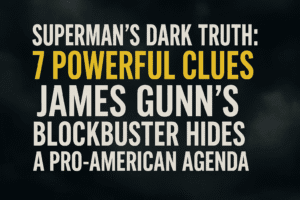James Gunn’s Superman arrives amidst global turmoil, sparking debate not just about its spectacle, but its politics. On the surface, it seems audacious: a fictional Eastern European nation, Boravia, invades Jarhanpur, a region evoking the Middle East or Ukraine. Superman intervenes. Lex Luthor, reimagined as a warmongering arms CEO, manipulates events from the shadows. To some, this screams a bold, “woke” critique of occupations like Gaza or Ukraine. But peeling back the layers reveals a narrative less revolutionary and more rehabilitative – a sophisticated exercise in repackaging American power.
The Allure of the Allegory (and Its Limits):
The parallels are undeniably tempting. Boravia’s aggression mirrors real-world occupiers. Jarhanpur’s plight resonates with images of displacement we see daily. Superman stopping the invasion feels like cinematic justice. Gunn deserves credit for threading contemporary anxieties into the blockbuster fabric. However, effective critique demands more than surface-level analogies. It requires confronting the root systems enabling such violence. Here, the film falters.
The Corporate Scapegoat and the Innocent State:
The film’s sharpest critique lands squarely on Lex Luthor and the arms industry – portrayed as the puppet masters profiting from endless conflict. This resonates; the war economy is a grim reality. Yet, this focus performs a crucial sleight of hand: it absolves the state.
The U.S. government in the film is depicted as Boravia’s reluctant ally, essentially tricked by Luthor into supporting the invasion. Officials appear as victims of corporate manipulation, devoid of their own imperial ambitions or historical culpability. This narrative is profoundly familiar and deeply problematic. It echoes the post-Iraq War refrain of “mistaken intelligence,” deflecting responsibility for catastrophic foreign policy decisions. The film subtly reinforces the myth: When America does wrong, it’s despite its inherently good intentions, never because of them.
Hollywood and the Military: An Enduring Partnership:
This deflection isn’t accidental; it’s part of a long tradition. The article rightly highlights the “military-entertainment complex,” a symbiotic relationship often obscured by popcorn and CGI. The Pentagon’s Entertainment Liaison Office actively collaborates with filmmakers, providing resources in exchange for influence over military portrayals. From Captain America punching Hitler in WWII propaganda comics to Marvel’s recent collaborations (like WandaVision crediting the DoD), superheroes have frequently served as sanitized avatars for American military might.
- Sanitizing Violence: Superhero films routinely depict massive “collateral damage” – cities leveled in pursuit of a villain. Batman wrecks Gotham; Superman likely does the same. This normalizes destruction, implicitly justifying real-world devastation under the banner of targeting “bad guys.” The staggering human cost of actual U.S. interventions fades against the backdrop of CGI rubble and a guaranteed heroic victory.
- Coding the Villain: While Gunn avoids direct real-world naming, the history is telling. Villains are often coded – think Bane’s desert-prison origins in The Dark Knight Rises, visually evoking the Middle East. This reinforces subconscious associations linking certain regions or cultures with inherent threat, a dangerous trope perpetuated by decades of such portrayals.
- The “Good War” Narrative: Films like Superman perpetuate the myth of the “clean” or “justified” intervention. The complex, often murky realities of geopolitics, resource interests, and historical grievances are flattened into a simple hero/villain binary where American power (embodied by Superman) is the only solution. This narrative actively works against accountability for past and present actions.
Why Context Matters More Than Ever:
The recent controversy over Marvel introducing Sabra (an Israeli Mossad agent superhero) and the subsequent protests highlight the real-world stakes. Celebrating Superman as “anti-occupation” or radically “woke” overlooks its deeper function within this established system. It uses a veneer of critique – necessary to feel relevant and credible – while ultimately protecting the core narrative of American exceptionalism and benevolent power.
The Real Insight: Watching with Critical Eyes:
Gunn’s Superman isn’t necessarily “anti-Israel” in a meaningful political sense, nor is it a genuine reckoning with America’s role in global conflicts. Its true significance lies in demonstrating how dominant narratives are repackaged for a skeptical age.
The insight for audiences isn’t to dismiss the film, but to engage with it critically:
- Question the Blame: Who is truly held responsible for the conflict? Are systemic government or intelligence failures examined, or is evil conveniently outsourced to a lone corporate megalomaniac?
- Analyze the Damage: How is destruction portrayed? Is “collateral damage” glossed over, normalized, or presented as an unavoidable cost of heroism? Does this mirror real-world justifications?
- Decode the Imagery: Are there visual or narrative cues linking villains to specific real-world cultures or regions? What stereotypes might be reinforced?
- Consider the Endgame: Does the resolution reinforce the idea that overwhelming American power (or its superhero proxy) is the only viable solution to complex global problems? Does it absolve institutions of past sins?
Superhero films remain potent cultural forces. Gunn’s Superman offers spectacle and, superficially, resonance with current crises. However, its ultimate power lies not in challenging the status quo, but in subtly refurbishing the image of American interventionism for a new generation, using the thin gloss of contemporary critique to mask an enduring and familiar agenda. Recognizing this mechanism is the first step towards demanding narratives that offer more than just rehabilitated myths. The real heroism lies in seeing beyond the cape.

You must be logged in to post a comment.